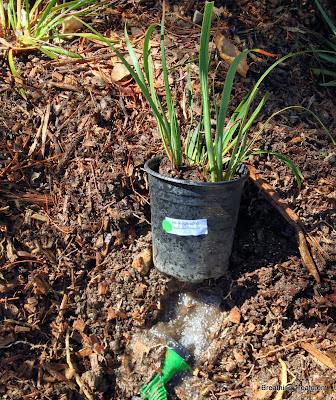The local chapter of the California Native Plant Society (SCCNPS) had their native plant sale the other day and of course I was there. Some of the plants have already made it into my garden. The SCCNPS sale features and identifies many locally native plants, many of which are propagated from local seed or cuttings. This year I found myself gravitating strongly to the locals.
This Red Buckwheat (Eriogonum grande rubescens) joined two others that I planted in the last year. Three is a magic number that has many visual aesthetics and one of the earlier plantings had died, a victim of animal activity in my garden, so I had to replace it.
Of the two existing in my garden before this new one was installed, one was planted somewhat earlier in the winter than the other and the earlier one is by far the larger and more robust. This just goes to illustrate that fall to winter is the best planting time for many of these native plants - they sink deeper roots that allow more top growth if they get just a few more weeks / months in the ground with cool temperatures and moist soil.
A new addition to my garden is Mugwort (Artemisia douglasiana). It was curious that the several pots of A. that I had to choose from at the plant sale had the lobed leaf / smooth leaf characteristic: This pot had the most lobed leaves and the other three that I saw were smoother. I have to imagine that A. douglasiana is propogated from cuttings, making the ones at the sale likely clones of one another, and raised in nearly identical soil / light / water. So why did this one have the lobed leaf shape and the others did not? I've asked the question before here on this blog. I asked again at the sale since there were many knowledgeable people there and I didn't get any answers. One of the more helpful web sites that I found on the topic simply states, "The leaf
shape varies for each population and even by the age of the plant and
growth stage." - Bay Natives
I'll let the A. douglaisiana go running through my rose garden and pop up where it wants to. Once established, I can pull it out where I don't want it. This pot was full enough that I was able divide it and plant it in two areas.
Augmenting an area already planted in 'Canyon Snow' Iris (Iris douglaisiana 'Canyon Snow') I added two more. Here I've pictured my process of filling an excavated planting hole with water before installing the plant. The pot also gets watered. Then the installed plant and soil around it gets watered. Watering is on an as-needed basis after that.
This is part of my garden that is adjacent to the street, so I want
something not too far from people's typical expectations (built upon East Coast
or European ideals that have no place in California, still I'm conscious
of neighborhood expectations). I'm replacing Agapanthus as I go and it
seems to be working quite well. The Agapanthus aren't real water hogs, particularly with the thick layer of mulch that I have down. However, I dislike them for multiple other reasons and I'm happy to see them go, even if it is gradually.
I also ordered from Annie's Annuals during their fall sale (it runs through Oct 13 in case you are interested), so I have a lot of planting to do this weekend what with the anticipated Annie's delivery and the remaining plants from the SCCNPS plant sale.



No comments:
Post a Comment